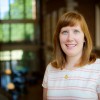This article is more than 5 years old.
My time in Milwaukee for the Midwest Archives Conference was not quite as jam-packed as Tanya’s but I made the most of the trip!
I was a member of a panel entitled “The Perfect Is the Enemy of the Good: Creative Solutions and Common Sense Approaches to Archival Problems.” My fellow presenters and I gave Pecha Kucha presentations: 20 slides, each 20 seconds; it was a fun mental exercise to distill our actions and key takeaways into 6 minutes and 40 seconds. I also acted as a MAC Pal for a first-time conference goer, which is a fun way to welcome new folks to the archival fold. My pal this year was a UW-Milwaukee student who had dabbled in archives and was attending in part to see if she was interested in pursuing archives further.
I attended a couple of sessions on diversity and inclusion, including the plenary talk from current Society of American Archivists vice president/president-elect Dennis Meissner of the Minnesota Historical Society. He covered many points about diversity and inclusion, but my takeaways were that individual and institutional biases affect workplace performance in very serious, and somewhat different ways, so we have to be aware of both. Also, in order to move towards increased inclusion, training is valuable for getting folks on the same page and mitigating biases.
I also attended a session on processing collections, “Seeing the Details in the Big Picture: Getting a Handle on Processing.” One woman had created nearly 1500 finding aids in two years (this is an astronomical number!), so I was curious to see how she managed that. Turns out that the collections were already physically processed – organized, housed appropriately, with folder titles – and she created biographical or historical descriptions and described the materials; she pointed out that without the physical arrangement work, 1500 finding aids would have been impossible. Another presenter who processed a huge collection with help from graduate students shared that, to process 1 linear foot of materials: inexperienced graduate students took 10 hours (!!!); graduate students with 1 year of processing experience took 3.25 hours; and professional archivists, 30 minutes. Good reinforcement that there’s no magical replacement for skilled labor.
In addition to all the learning, I saw some of my former Iowa State colleagues, got to test out a (stationary) Harley Davidson motorcycle at the Harley Davidson Museum (they have a huge archival repository of bikes, parts, tools, etc), and took a stroll through the Milwaukee Art Museum. All in all, it was a great and busy MAC!

7 Comments on ‘Stephanie at the Midwest Archives Conference 2016’
Difference between 10 hours and 30 minutes is definitely an indication of the expertise professional archivists provide.
“The Perfect Is the Enemy of the Good” is one of my favorite sayings! I want to hear more about the diversity and inclusion sessions! Thanks for posting!
I thought doing a Pecha Kucha was one of the most difficult presentations I ever attempted! Especially if you don’t have control of the slide advancement!
Those stats on inexperienced vs experienced labor were quite interesting. Thanks for including them in your report!
What, no stats on a roomful of monkeys processing 1 linear foot?
You find the best museums to tour, Stephanie!
It seems like many conferences/meetings are discussing inclusion and diversity…you gleaned some key takeaways that I haven’t often heard noted!